June 2019
From Jan Hennessey:
|
|
|
 |
Epidendrum parkinsonianumFound from Mexico to Panama, I grow it in the pergala, warm losts of humidity.Reduce water somewhat in winter. I have had it for more than 15 years. |
|
|
|
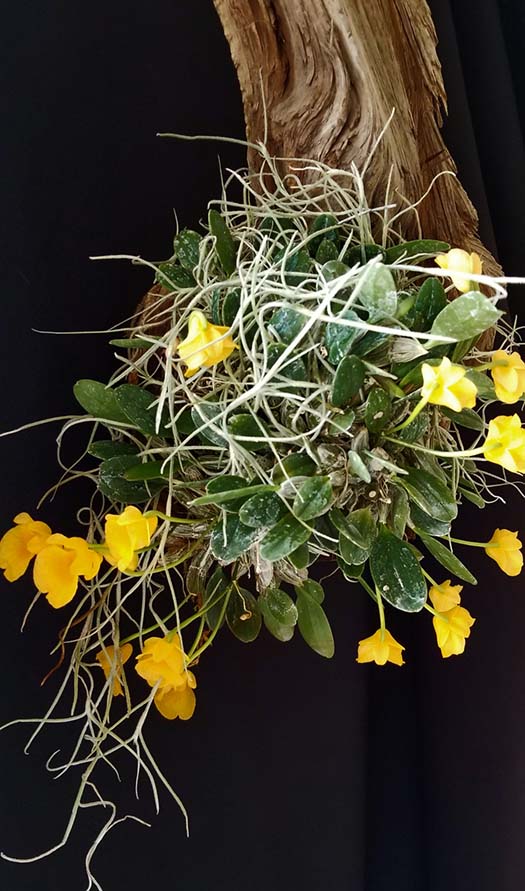
Dendrobium lindleyiMounted 2 yrs ago, never bloomed prior to that. Now in the greenhouse and she blooms. From Asia and surrounds.
|
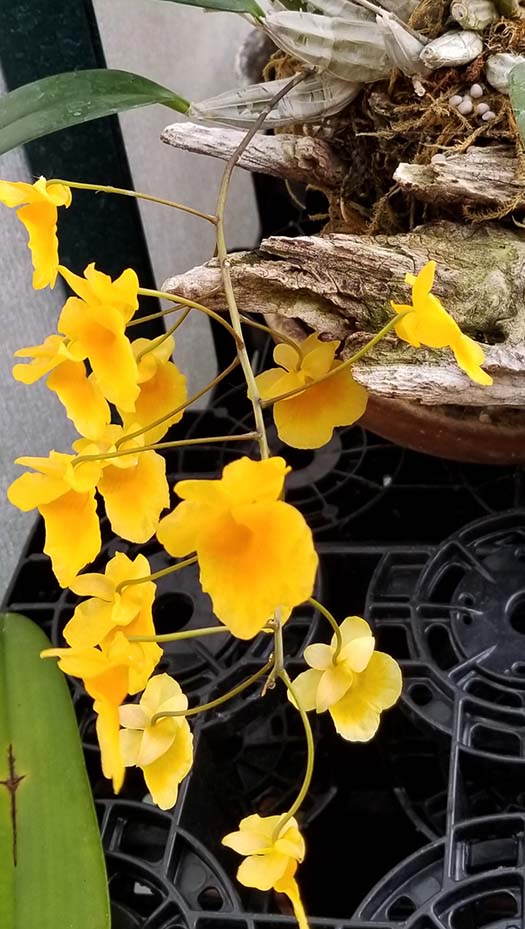
Dendrobium aggregatumAlso mounted horizontally. Bloomed for the first time. Another in a basket did not bloom this year and rats ate all the inflos last year, very sad day. |
Den lindleyi and Den. aggregatum are considered to be synonyms. However, the Den. lindleyi (which has a tag) has small pseudobulbs, not same shape as the one labeled "aggregatum", and also has short stems. The flowers, however, look the same. |
|
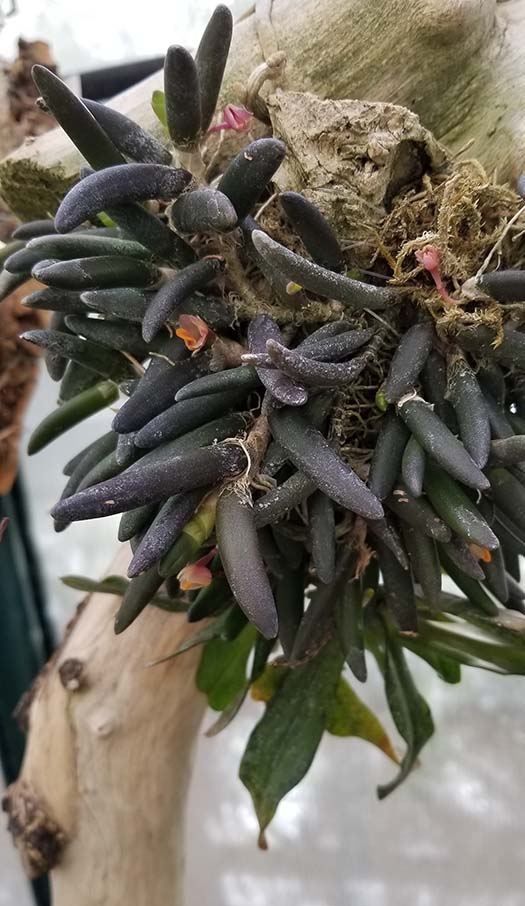 |
 |
Den lichenastrum v. prenticeiMounted for a few years now, cool to warm, from Austrialia. Doesn't like to be disturbed, in the greenhouse. |
|
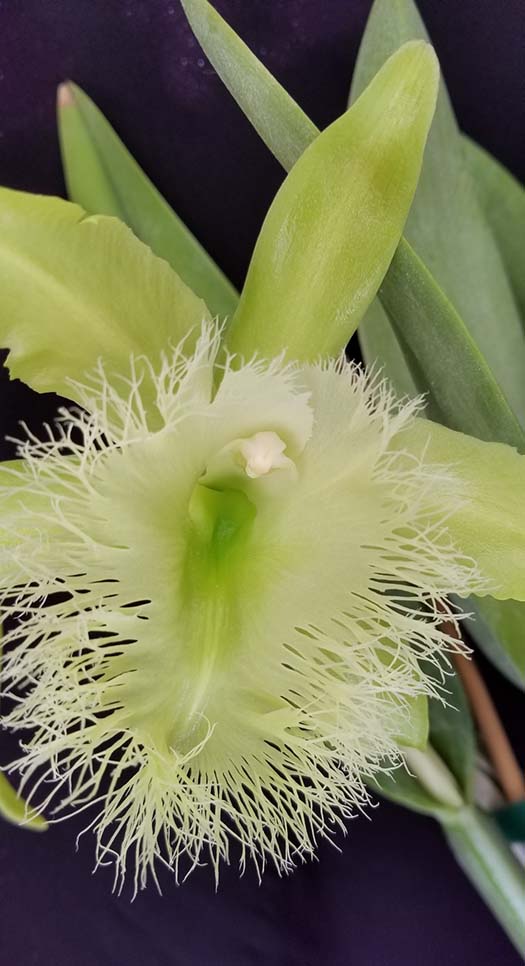 |

Rhyncholaelia digbyanaHaven't had this one very long, very fragrant, from Mexico to Belize. Hot to warm and kept in a tight pot with very good drainage, reduce water in winter. |
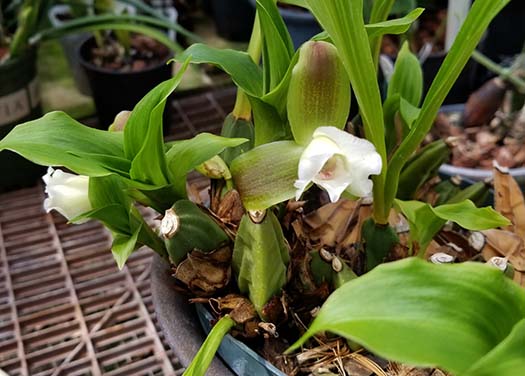 |
Lycaste dowianaHad it since 2006, easy grower and takes my abuse, in the greenhouse. |
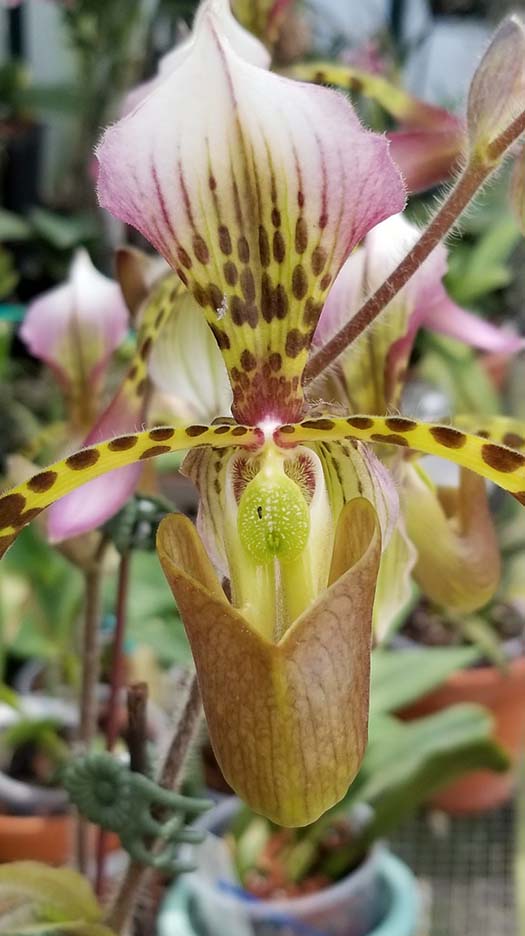 |
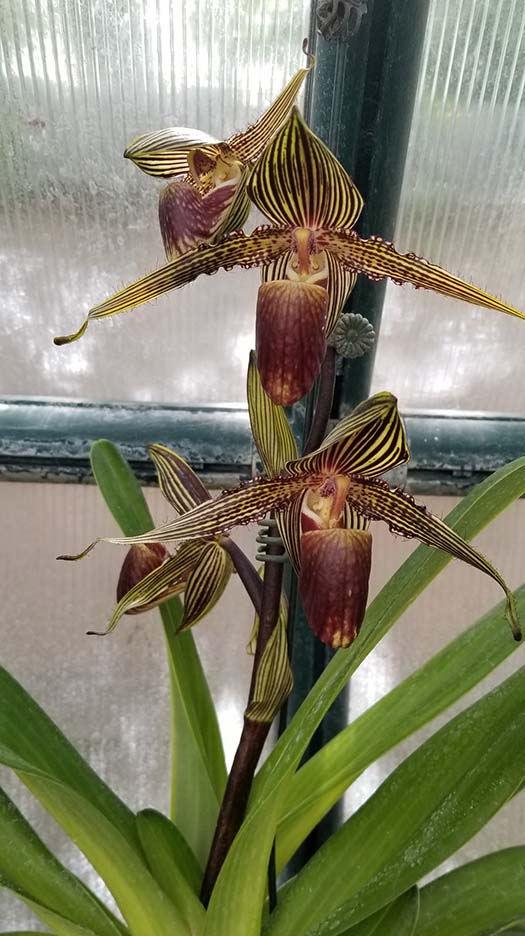 |
Paphiopedilum haynaldianumThis AM plant from Dale Hallberg I've had for more than 18 years. Been divided and shared many times Likes shady, bright light, lots of water with good drainage. |
Paphiopedilum rothschildianumFirst blooming, from my daughter. Found in Borneo |
From Cindy Jepsen:
|
|
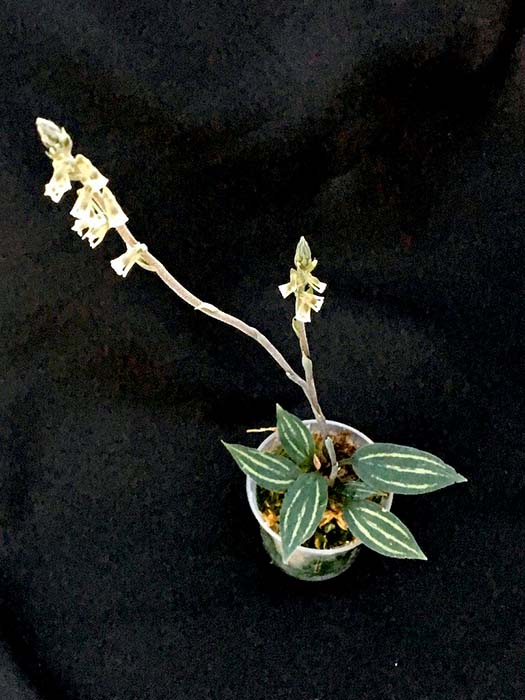 |
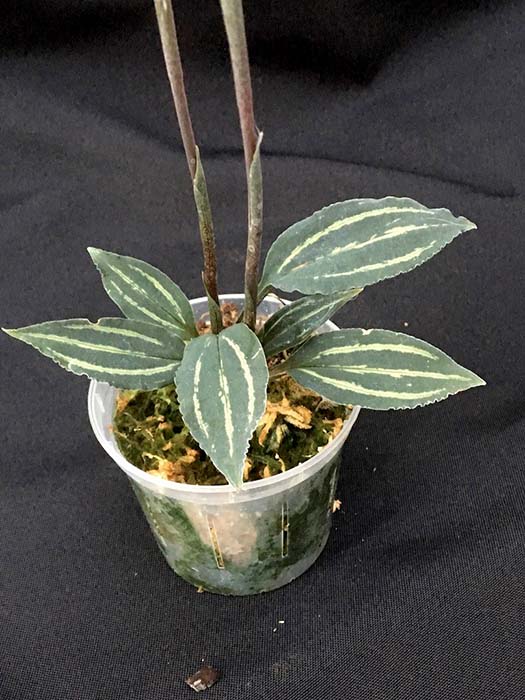 |
 |
Cyclopogon lindleyanusA new species for me this year. Got this from Ecuagenera in January. It’s maintained slow steady growth and has rewarded my care with two long spikes. It’s not fully open but I couldn’t resist sharing it. Notice the beautiful foliage. It came potted in sphagnum and I keep it low in my greenhouse where it receives low lighting, 60% humidity and so far the temperature has been between 56-87°. I water with an RO system several times a week and feed weekly with MSU, seaweed and Superthrive on a rotating basis. |
 |
 |
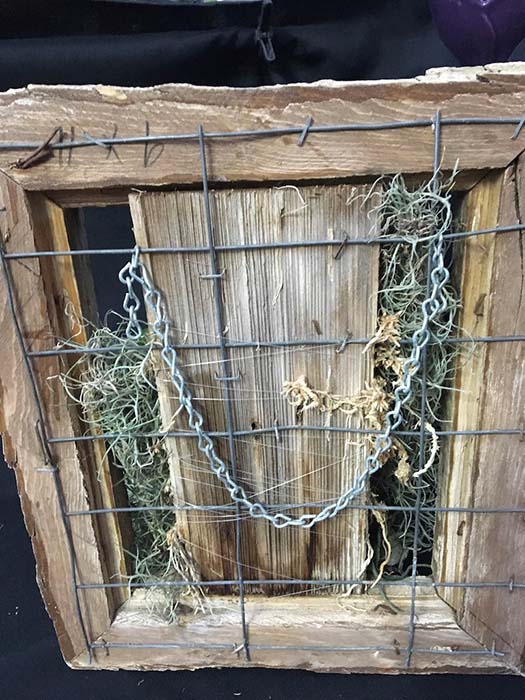 |
 |
Encyclia (Prosthechea) cochleataThe flower is not completely uncurled. I have two of these beauties, one potted in bark and this one mounted on cedar with sphagnum moss. I have wire fencing stapled to the backside of an old wooden picture frame and the cedar mount stapled to it. It is wonderful for displaying at shows. This one blooms faithfully twice a year whereas the potted one has yet to bloom. Look closely and you will see an additional bud forming. I keep it low in my greenhouse where it receives medium lighting, 60% humidity and so far the temperature has been between 56-87°. I water with an RO system several times a week and feed weekly with MSU, seaweed and Superthrive on a rotating basis. |
|
From Scott McGregor:
|
|
Dendrobium parvulum (blue)Finally bloomed! Obtained in 2017, so it has gone through two winters. A must-have for collectors of truly blue orchids |
 |
Dendrobium parvulum (white)Got this white one (purchased as blue, guess not...) in 2013, and it blooms regularly between January and April. Too bad that they don't want to bloom at the same time. But both seem to enjoy our coastal climate. |
|
Leptotes bicolorGot some nice large flowers on this selected clone (4N, doubled chromosomes). This species, besides the better known ones in the Vanilla family, produces vanillin in its seed pods and can be used for flavoring. Like commercial vanilla pods, Leptotes seed pods have to be carefully harvested before they split, and processed. Here’s a link on the overall process in case you’d like to give it a try: https://www.cooksvanilla.com/the-art-of-curing-vanilla-beans/. (Ed. note... if the link doesn't work, copy text and paste into browser Address line) Mine came out ok and definitely had a vanilla scent, but given the amount of work, in the “fun once” category of experiences! |
Here are two flowers of Leptotes bicolor from two different plants. The larger, nicer one is a selected 4N clone (double chromosomes) and the smaller, less open flower is more typical. Clearly your mileage can vary on these, so buy one when you can see the flowers, or decide to pollinate the flowers and make vanilla! |
Maxillaria minutaOK, this is one perhaps only its mother could love, but the plant does grow into an attractive clump (when not in bloom) and every spring there are red-brown flowers between all the leaves. The flowers are about ¼” across and the whole plant is about 4”. |
|
Plerurothallis scheidii (ornata)This is one of my favorite micro-mini’s. It blooms prolifically in the Spring, with successive flowers on each of many stems. The flower itself isn’t especially pretty, but it has white “tassels” at the ends of each petal that flutter in the very slightest breeze. It is difficult to photograph, not just because of the small flower size, but the tassels quickly become “windblown”. Here’s a pic of the flower from today, slightly windswept, and from a flower on a perfect day many years ago that I sent in to OrchidSpecies.com. |
|
 |
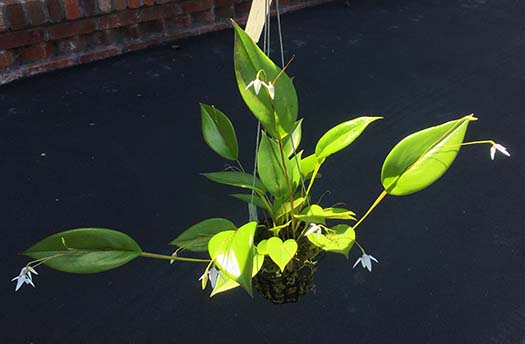 Pleurothallis viduataThis one grows like a weed outdoors here and blooms multiple times per year—lots of small white flowers with purple markings. |
Diplocaulobium twinsDiplocaulobiums are relatively easy to grow outside, have pretty flowers, bloom often, some have a strong scent of watermelon, but the flowers last only a day. What a treat it was this morning to have my two different white-flowered species open multiple flowers at the same time. The top one in this picture was purchased as D. arachnoideum and the bottom one as D. aratiferum “Watermelon Rind”. Maybe you have better eyes but they look absolutely identical to me! I suspect they may both be D. arachnoideum—the perils of buying plants from EBay I suppose. Anyway, I’ll enjoy the pleasant watermelon scent from two plants at once, but just for today. See the April 2019 edition for a time-lapse of these flowers opening last time the plant was in bloom |
Diuris drummondiiMy last Mediterranean terrestrial—the tall donkey orchid from Australia, Diuris drummondii. Both of my plants put on a good show this year and this last one to flower has been in bloom for over a month. These will now go dormant, with no water, until Autumn rains. |
Capanemia superflua (uliginosa)Here’s another micro-mini bouquet from two different plants. It is a twig epiphyte, so likes to be mounted—one on a board and the other on half of a 1” pot. It is fragrant too.
|
|
Maxillaria tenuifoliaCan you have too much Maxillaria tenuifolia? As Mae West famously said, "too much of a good thing is wonderful". I got this plant in a 4" pot eight years ago and it has thrived and been so happy, I've never divided or repotted it. I'm sure there's nothing left of the original potting material and so the plant gets its need met by an occasional watering from the hose and weekly fertilizer spray in the summer months. There are nearly a hundred flowers currently open and more coming-- they smell intensely of coconut and you can't help but notice if you're near the plant when it is in bloom. I know, it really needs to be divided and repotted so it will look nicer-- maybe next year... (Just measured, 44" x 30" approxomately) |
Slug patrolSlug (and anything else that moves) patrol... I have three of them. White’s Tree Frogs from Indonesia— they do fine outside with what they can find and some supplemental crickets. They hide during the day and come out after dark, hence the big (cute) eyes. They are completely docile, don’t fear humans, and will happily sit on your hand until you get bored. Definitely cuts down on the bad bugs and slugs, but you have to avoid broad use of pesticides. |
From Roberta Fox:
|
|
Outside in the back yard |
|
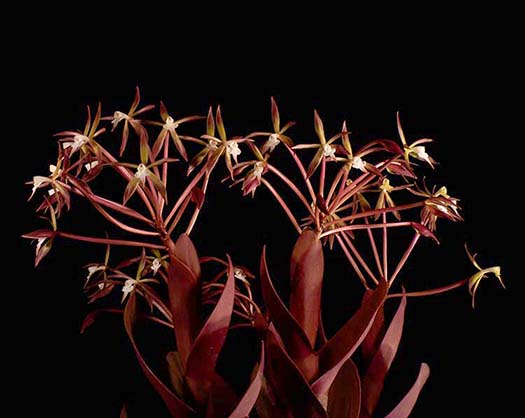 |
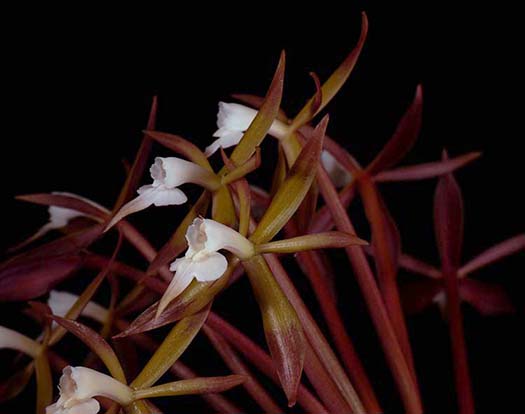 |
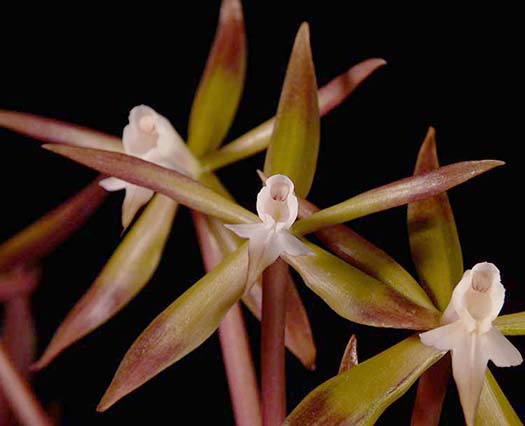 |
Epidendrum lacustre 'Wow Fireworks'This is the purple Panama form of the species. Every year this plant puts on a show - it does look to me like a burst of fireworks, so that's the cultivar name I chose when it got awarded. I now have several pots of it, because it is also super-vigorous, and each pot has multiple growths, each with a multi-flower inforescence. The formula for growing it is "full sun, sopping wet". It hangs with the L. anceps, but to meet the moisture requirement is in plastic pots with sphagnum, right under a sprinkler. With even a little shading the color is not as pronounced. |
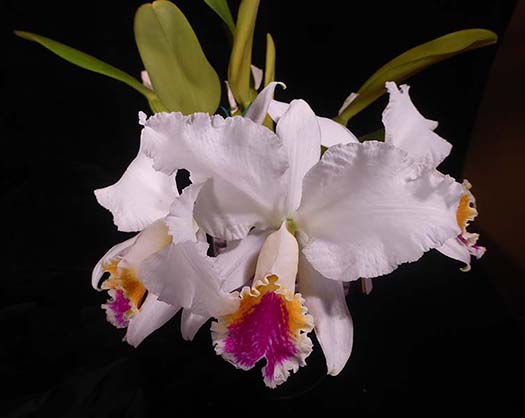
Cattleya mossiaeThis grows under polycarbonate, so gets a little protection from winter rain, but otherwise gets whatever Mother Nature gives it. Flowers are about 7 inches across, and extremely fragrant. |
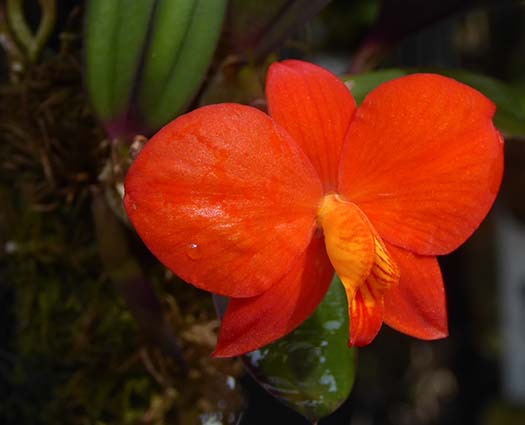
Sophronitis bicolorSmaller than S. coccinea (a bit less than 2 inches) but just as colorful. The contrast of the yellow side lobes of the lip add a dramatic touch. When this got reclassified as "Cattleya" the species name "bicolor" was already taken, so it became "Cattleya dichroma." |
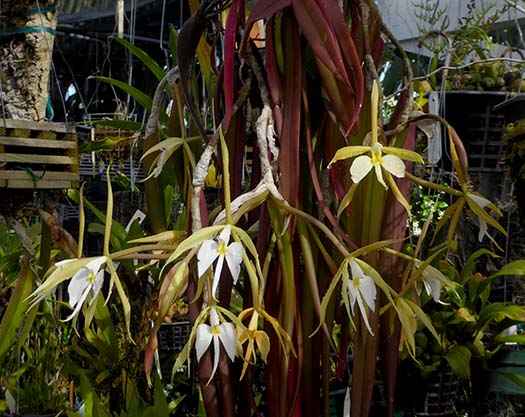 Epidendrum parkinsonianumReally floriferous, but it's not all one plant. I got it that way - at the time, about six seedlings were planted with sphagnum in an inverted wooden basket, tied to hold them in place. It has rooted well into and around the basket, and each plant is growing well. Epi parkinsonianum needs to grow mounted and hanging, but a little extra moisture around the roots seems to be helpful. Not awardable since it is multiple plants, but it sure puts on a spectacular show and very fragrant, especially in the evening. |
|
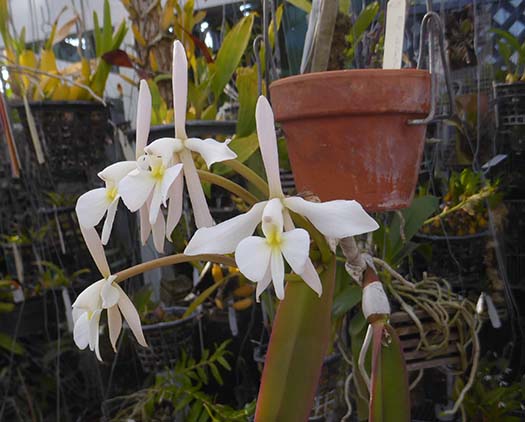
Epidendrum falcatumThis is a close relative of Epi. parkinsonianum, with a similar growth habit. The flowers are somewhat smaller. Also, rather than simply hanging down, growths come out nearly horizontal so it forms more of a clump. However, the individual growths are also very brittle, and break off easily when the plant is moved. I no longer take it to meetings for that reason. I have played with ways to mount the broken pieces, and this seems the most successful. I enlarged the hole in a terracotta pot, inserted the base of the growth where it broke into the hole, and tied it to a small stick to keep it in the pot. Then I added bark to the pot. This seems to provide enough moisture so that it has rooted well inside the pot and is starting to attach roots to the outside bottom of the pot as well as the plant grows. |
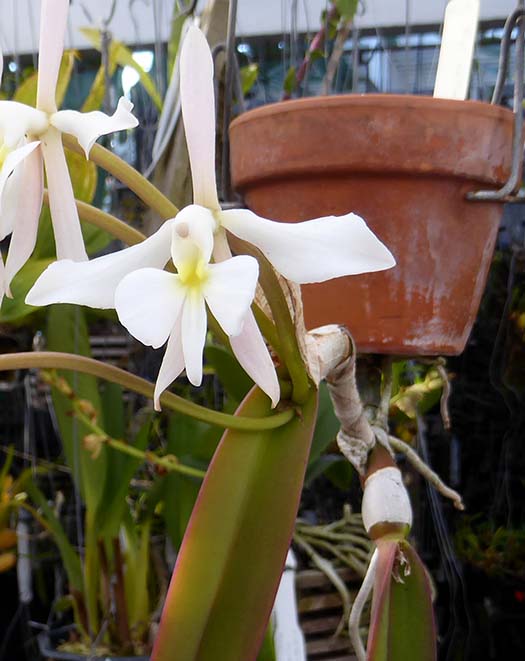 |
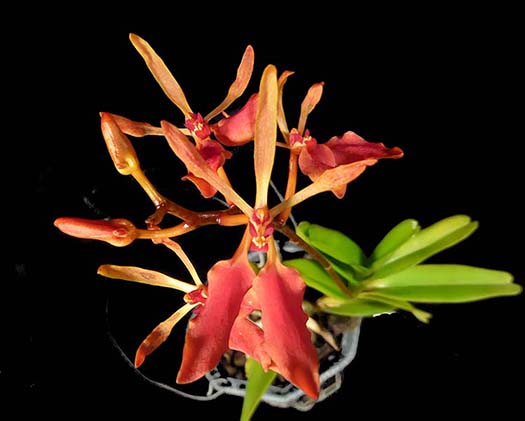
Renanthera pulchellaThis is a compact Vandaceous species. Flowers are a bit larger than an inch, the whole plant is only about 6 inches tall. It grows in a 4 inch basket with medium bark, in bright shade or filtered sun. |
|
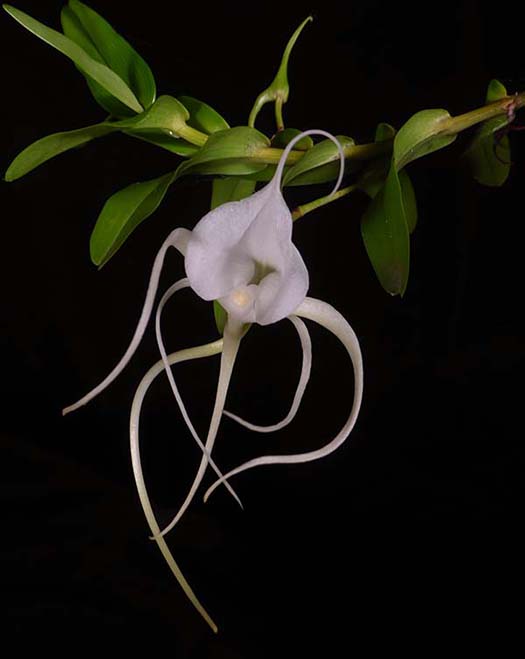
Angraecum germinyanumGrows shady and damp. |

Dendrobium loddigesiiThis is deciduous and kept quite dry in winter. Now, it's exploding with flowers, and just starting to grow some leaves. It needs to be in a basket, since the canes tend to be pendant. |
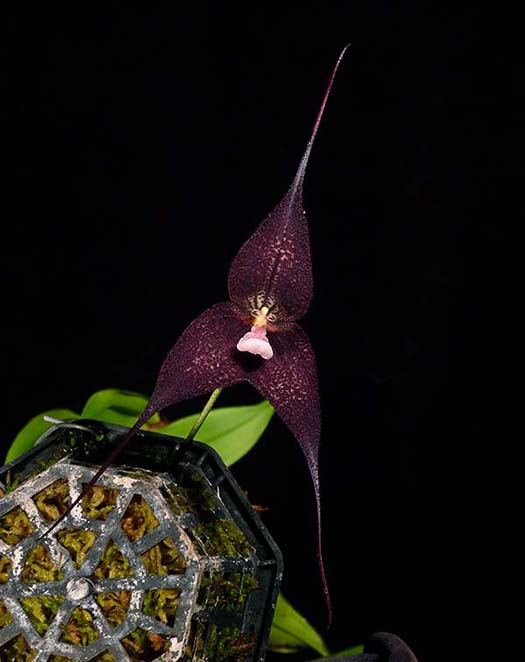 |
Dracula roezliiGrows shady and damp, but seems to be OK with summer temperatures. It is at its best in the cool of the morning, partially closing as the day gets warmer. That is a 4 inch basket, which gives an idea of the spectacular size of the floer. |
 |
 |
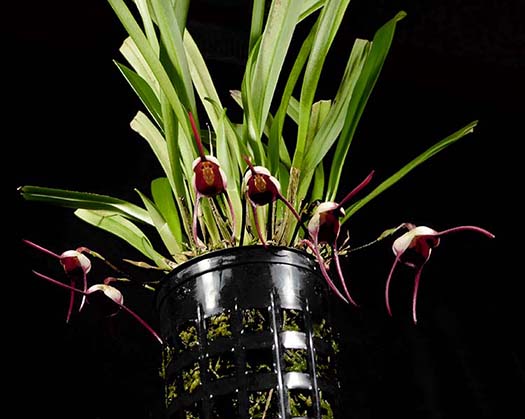 |
 |
 |
Dracula benedictiiFlowers are small, but there are lots of them. This one also grows shady and damp. The most recent photo, above, shows the plant in a 4 inch basket. |
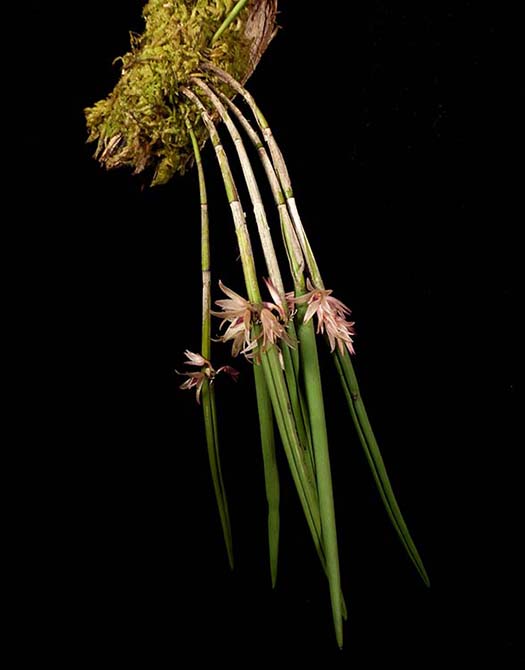 |

Octomeria praestansThis pleurothalid has thick, succulent leaves. I couldn't find out much about its habitat, but the leaves would indicate that it is at least seasonally dry. It blooms at least twice a year, sometimes more. |
In the greenhouse... |
|
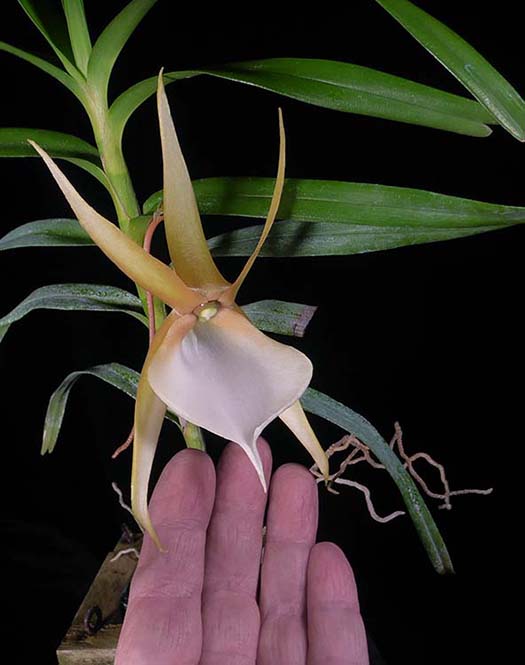
Angraecum viguieriA big flower, with rich color. It also has very interesting, warty roots. |
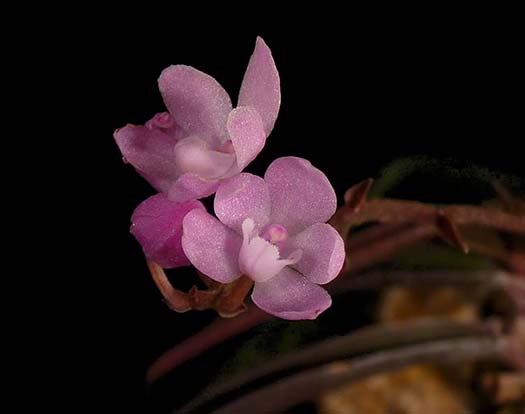 |
Sarcochilus ceciliaeI grew this outside for a couple of years and it did marginally OK, but it seems happier in the greenhouse. It does come from Queensland, in the northern, tropical part of Australia. Unlike most of the other Sarcochilus species, it is continues to bloom sequentially for several weeks or more. |
|
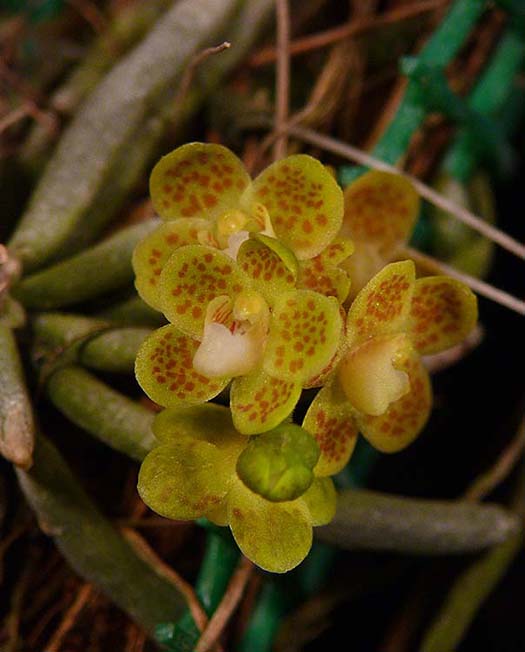
Chiloschista sweelimiiComplete leafless. It photosynthesizes with its green roots. |
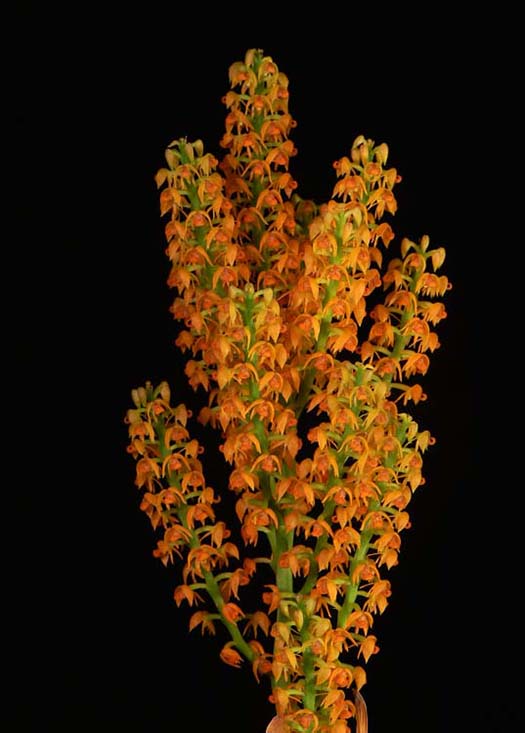
Polystachya paniculataThe contrast between the orange flowers and the green panicle is dramatic. |
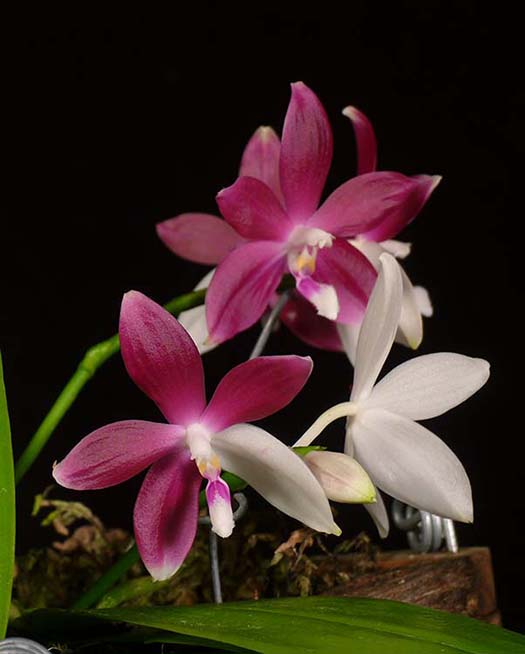 |

Phalaenopsis speciosaEach flower is different, from nearly all red to nearly all white, and every other combination on petals and sepals. It is very closely related to Phal tetraspis, which has similar variation of flower colors. |
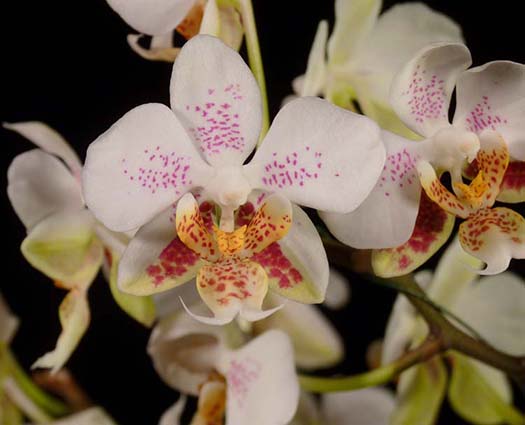
Phalaenopsis stuartiana, typical formThis form has dramatically mottled leaves. |

Phalaenopsis stuartiana v. nobilisAlong with the brilliant yellow color, this variety also has very little mottling on the leaves, which are more bronze than green. |
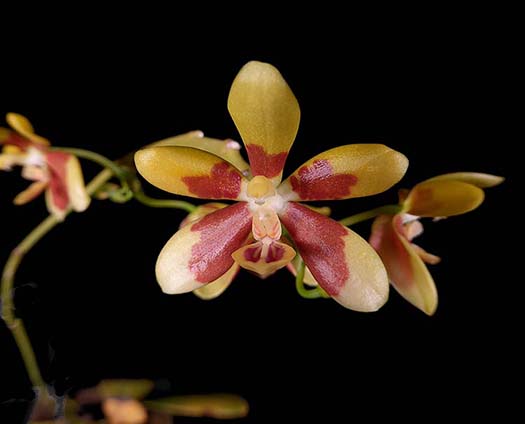
Phalaenopsis fuscataDramatic colors, and also a distinct lip shape. |
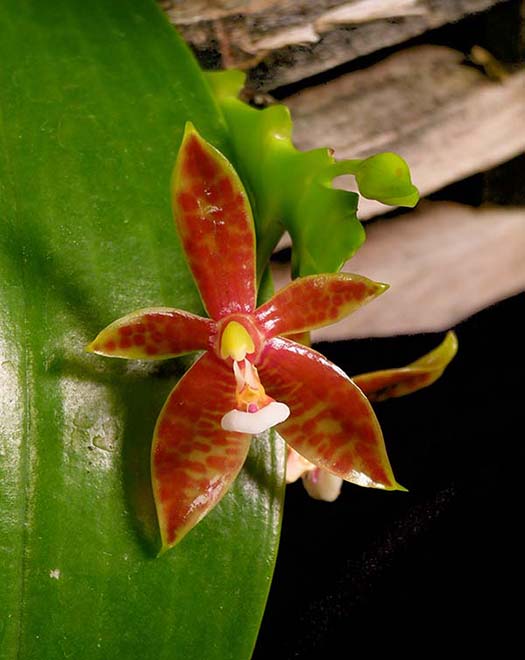
Phalaenopsis cornu-cerviLast month I showed you one of the red forms of thsi species. This one is more typical, with red and yellow bands. This species blooms sequentially, and as it elongates, the inflorescence acquires a scalloped appearance where previous flowers emerged. |
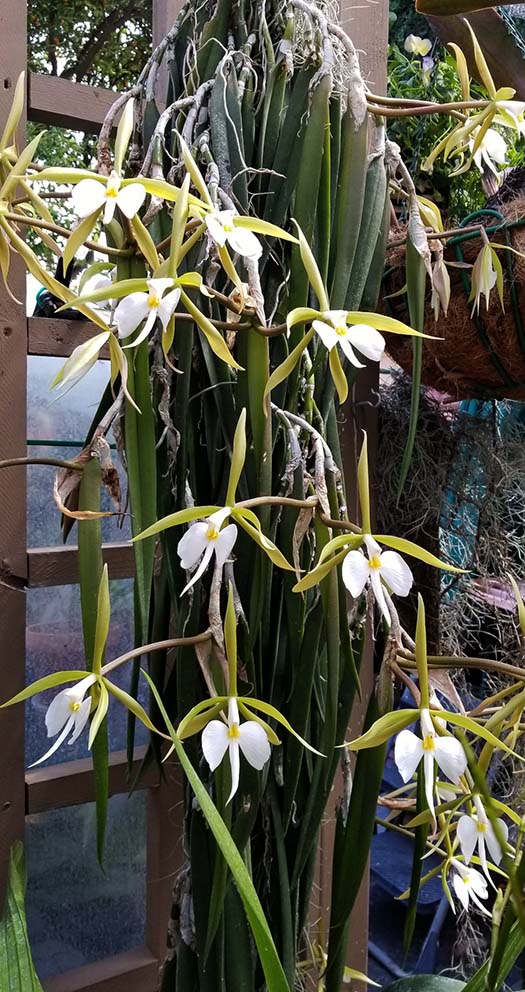
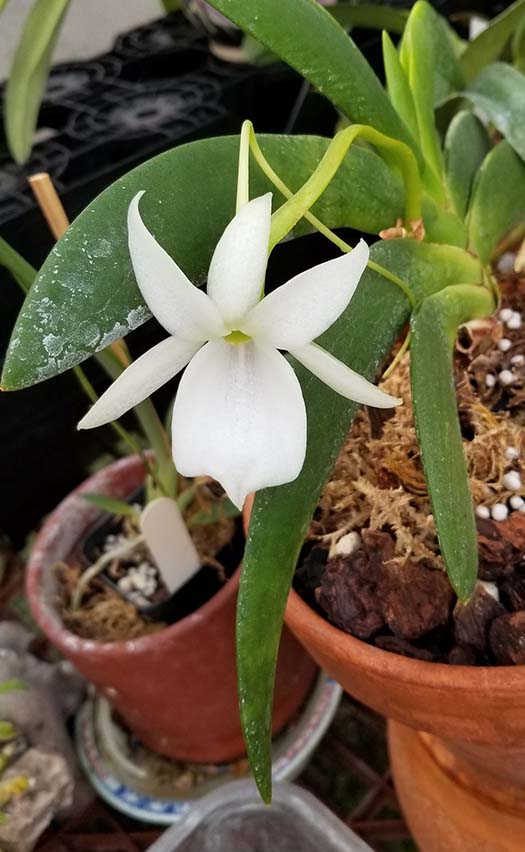 Haven't had this one very long, very fragrant, from Mexico to Belize. Hot to warm and kept in a tight pot with very good drainage, reduce water in winter.
Haven't had this one very long, very fragrant, from Mexico to Belize. Hot to warm and kept in a tight pot with very good drainage, reduce water in winter.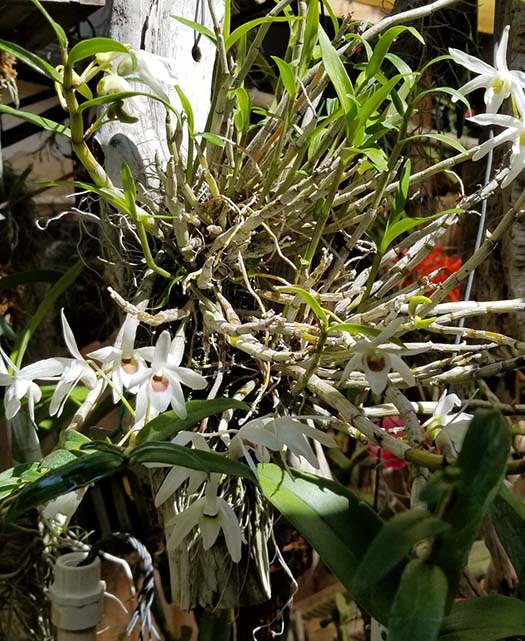 The Japanese stone orchid, grows in the kumquat tree, cool to hot bright light, drier in winter, but in the tree, it gets what it gets.
The Japanese stone orchid, grows in the kumquat tree, cool to hot bright light, drier in winter, but in the tree, it gets what it gets.

